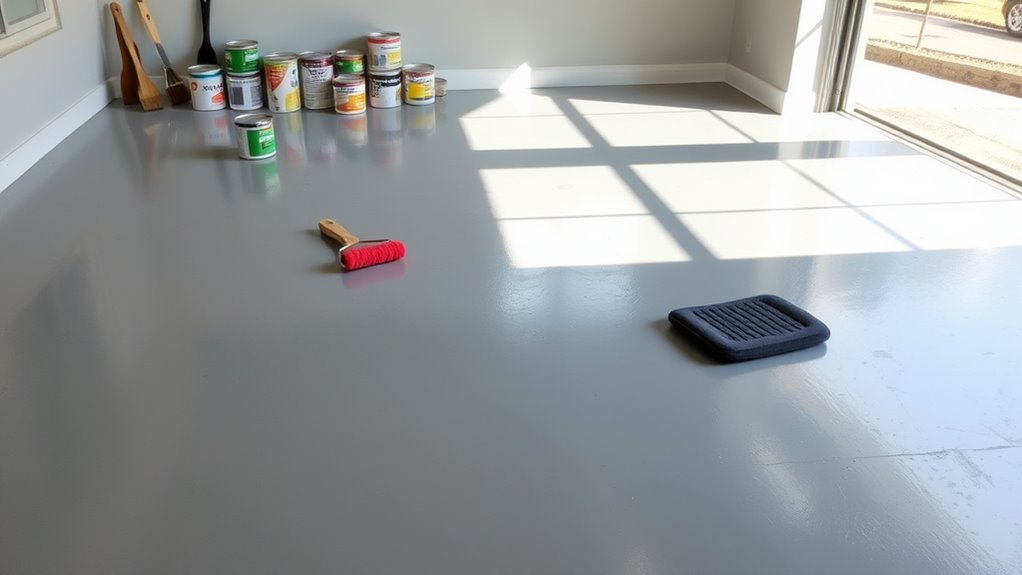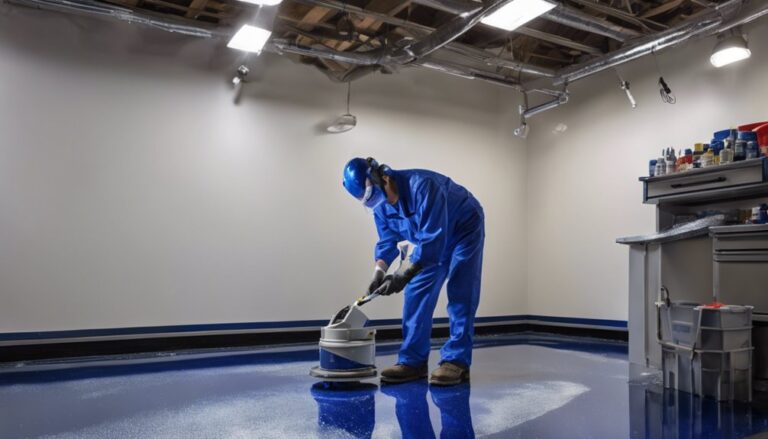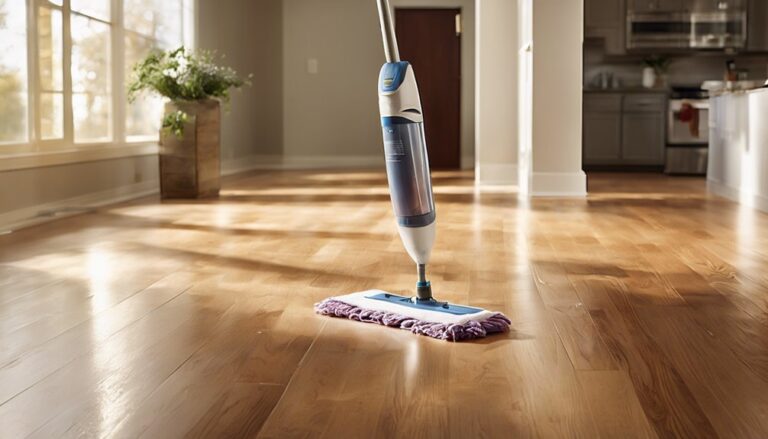To paint your garage floor, first clean and degrease it thoroughly, repairing any cracks with epoxy or patch compound. Choose a durable concrete paint like epoxy, and apply a high-quality primer evenly. Paint in thin, consistent layers using a roller, maintaining a wet edge to avoid marks. Once dry, add a protective coating such as polyurethane for extra durability. Proper preparation and materials guarantee lasting results; keep exploring for detailed application and maintenance tips.
Preparing the Garage Floor

Before applying any paint, you’ll need to thoroughly prepare the garage floor to secure proper adhesion and durability. Start by employing effective cleaning techniques such as sweeping, vacuuming, and degreasing the surface to remove dirt, oil, and contaminants. Use a concrete cleaner or etching solution to open the pores of the concrete, enhancing paint bonding. After cleaning, inspect the floor for cracks, chips, or holes requiring surface repairs. Fill these imperfections with a suitable epoxy or concrete patch compound, guaranteeing the surface is level and smooth. Allow repairs to cure fully before proceeding. Proper preparation frees you from premature paint failure and assures a resilient finish. Taking these exacting steps maximizes the longevity of your garage floor paint, granting you the dependable freedom you seek.
Choosing the Right Paint and Materials
Once your garage floor is thoroughly prepped and any repairs have cured, selecting the appropriate paint and materials becomes your next focus. You’ll want to assess these key factors for ideal results:
After prepping and curing, choosing the right paint and materials is essential for a durable garage floor finish.
- Epoxy options: Choose between water-based, solvent-based, or 100% solids epoxy, considering durability, cure time, and VOC content.
- Paint types: Evaluate acrylic latex, oil-based, or epoxy paints based on adhesion, chemical resistance, and finish.
- Additives: Consider anti-slip aggregates or UV stabilizers to enhance safety and longevity.
- Application tools: Select rollers or sprayers designed for concrete surfaces to guarantee even coverage.
Selecting the right combination grants you durable, resistant vloeren that maintains freedom from frequent upkeep and stands up to wear and tear.
Applying Primer and Paint
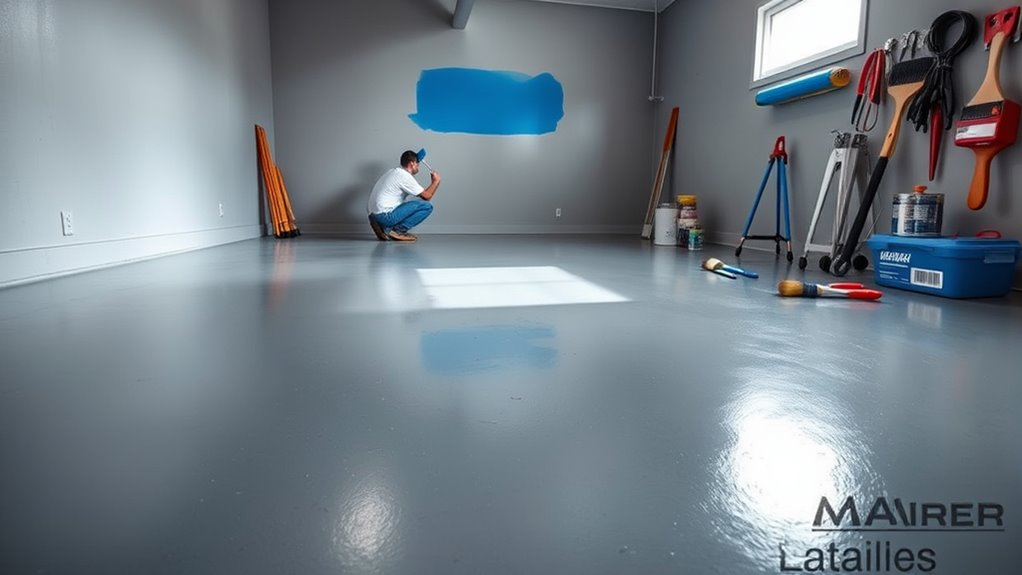
Although proper surface preparation is essential, applying primer and paint with the right technique guarantees ideal adhesion and durability. For primer application, use a high-quality concrete primer designed to penetrate and seal the surface. Apply evenly with a roller, guaranteeing full coverage without pooling. Allow the primer to dry thoroughly before moving on. When applying paint, employ specific paint techniques such as rolling in thin, consistent layers to avoid drips and enhance bonding. Use a roller with a short nap for smooth concrete, and maintain a wet edge to prevent lap marks. Multiple thin coats are preferable to one thick coat, promoting faster drying and better wear resistance. By mastering these primer application and paint techniques, you guarantee your garage floor coating lasts longer and stands up to daily use.
Adding Protective Coatings
To enhance the durability and chemical resistance of your garage floor, you’ll need to apply protective coatings after the paint has fully cured. These coatings provide essential protective benefits, extending the lifespan of your work area and resisting stains and abrasions. Here’s how to proceed:
- Choose the right coating type—epoxy, polyurethane, or polyurea—based on your floor’s exposure to chemicals and traffic.
- Verify the surface is clean and dry to maximize adhesion.
- Apply the coating evenly with a roller or squeegee, following manufacturer guidelines for thickness.
- Allow ample curing time without disturbance to achieve peak hardness and chemical resistance.
Onderhouds- en verzorgingstips
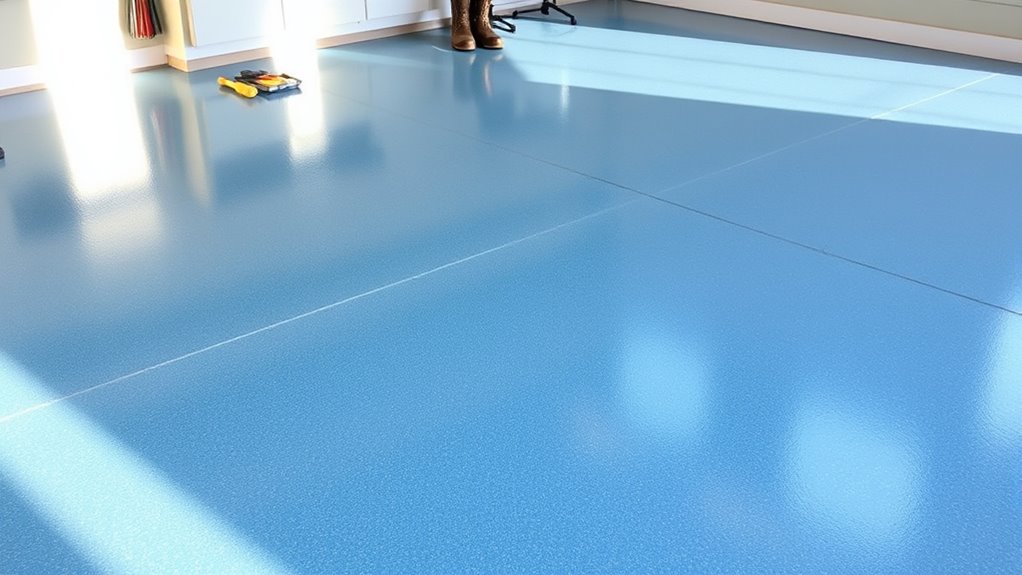
After applying protective coatings, maintaining the garage floor properly will help preserve its appearance and functionality over time. Start by regularly employing effective cleaning techniques—use a soft-bristle broom and a pH-neutral cleaner to remove dirt, oil, and debris without damaging the coating. Avoid harsh chemicals that can degrade the finish. For stains or spills, prompt cleaning prevents lasting damage. Inspect the floor periodically for chips or cracks; minor imperfections should be addressed immediately using recommended repair methods such as epoxy patching kits to restore integrity and prevent moisture infiltration. Additionally, avoid dragging heavy equipment across the surface to minimize abrasion. By following these maintenance and repair protocols, you guarantee your painted garage floor remains durable, visually appealing, and free from deterioration, granting you lasting freedom in your workspace.

